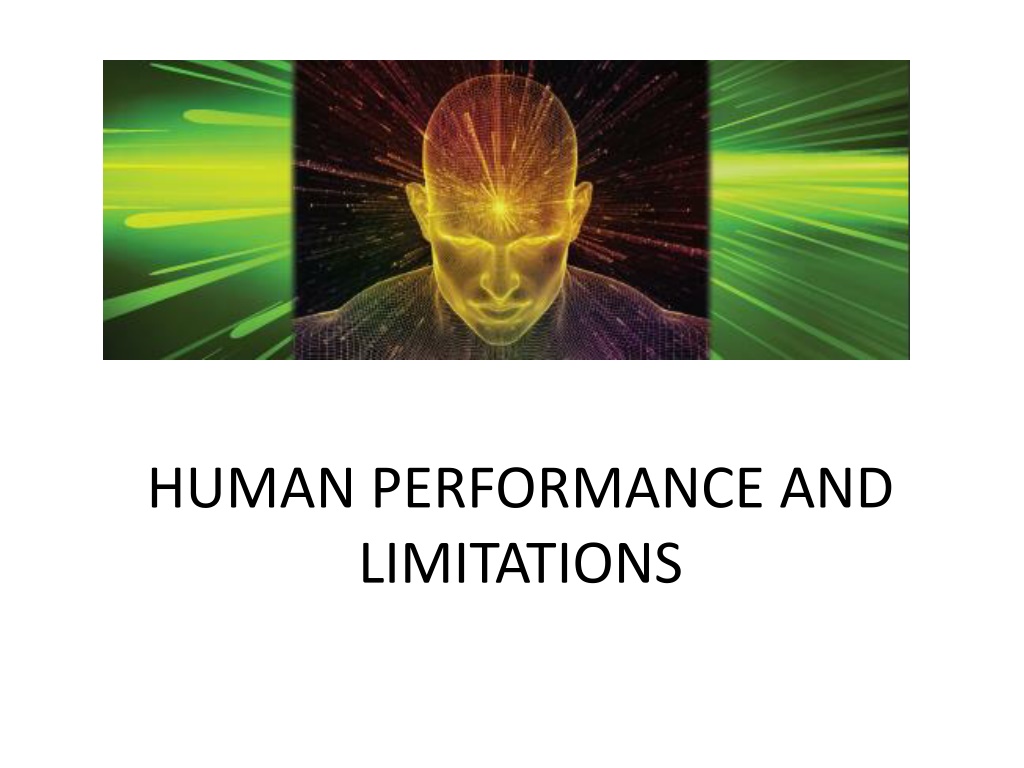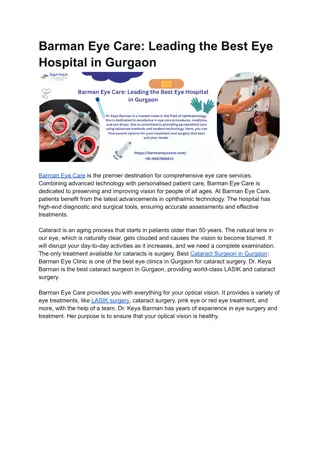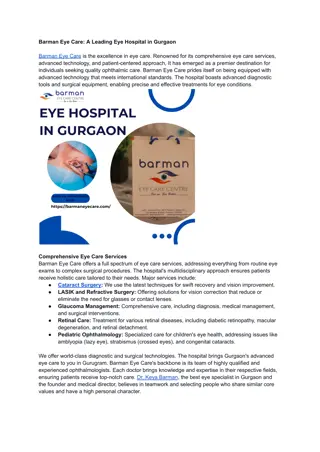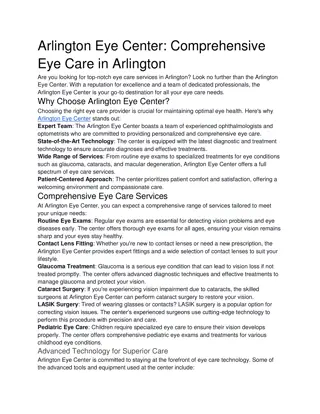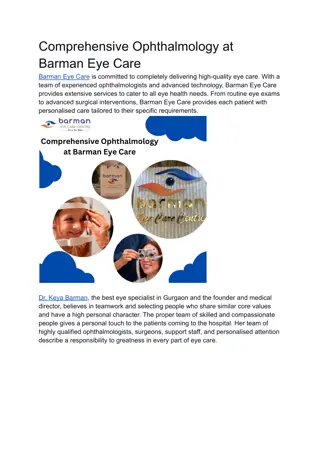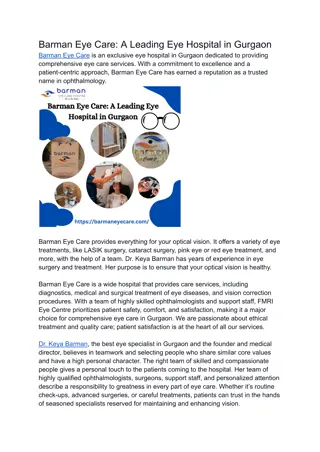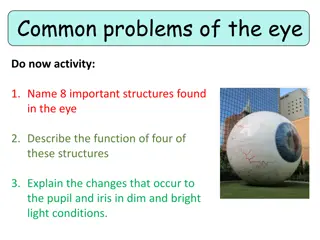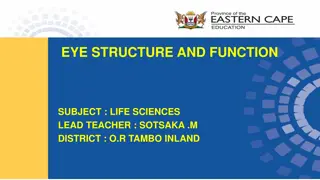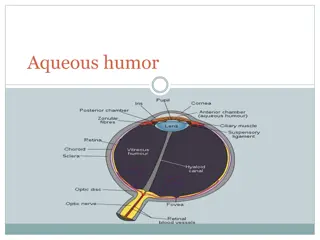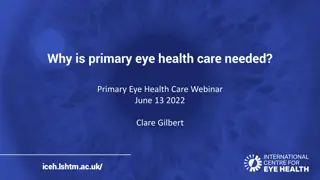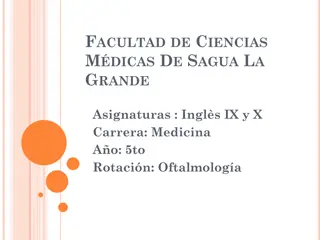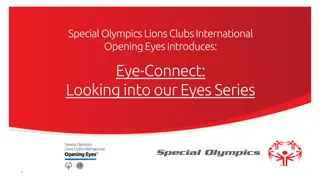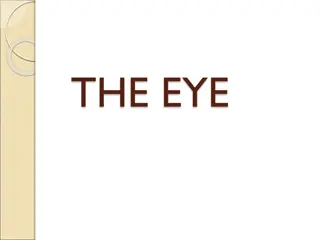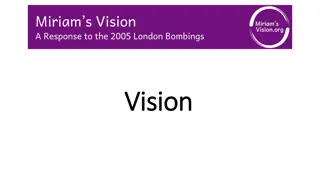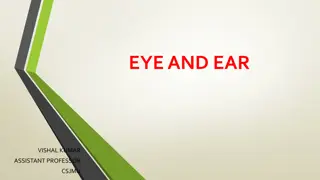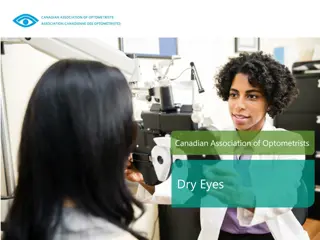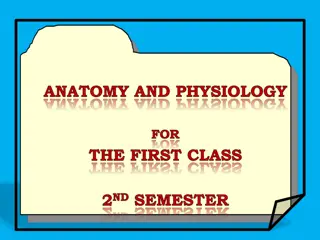Understanding Human Vision and Eye Function
Human vision is essential for many tasks, especially in professions like aviation maintenance technicians. Proper lighting and eye protection are crucial for optimal vision. The eye functions like a camera, with components including the cornea, iris, lens, and retina. Each part plays a vital role in the visual process, from light entering through the cornea to the interpretation of images in the brain. Understanding the components and functions of the eye can help in appreciating the complexity of human vision and the importance of maintaining eye health.
Download Presentation

Please find below an Image/Link to download the presentation.
The content on the website is provided AS IS for your information and personal use only. It may not be sold, licensed, or shared on other websites without obtaining consent from the author. Download presentation by click this link. If you encounter any issues during the download, it is possible that the publisher has removed the file from their server.
E N D
Presentation Transcript
HUMAN PERFORMANCE AND LIMITATIONS
VISION Vision is vital for AMTs. Think of how much is subject to visual inspection. Vision is best when ensuring appropriate lighting to illuminate the work area, and best protected by ensuring that protective eyewear is clear and suitable for use. An individual s lack of color discrimination, or defective color vision, may make it difficult to distinguish between red and green, even with appropriate illumination
THE BASIC FUNCTION OF THE EYE The basic structure of the eye is similar to a simple camera with an aperture (the iris), a lens, and a light sensitive surface (the retina). Light enters the eye through the cornea, then passes through the iris and the lens, and finally falls on the retina. Here the light stimulates the sensitive cells on the retina (rods and cones) which then pass small electrical impulses by way of the optic nerve to the visual cortex in the brain. Here, the electrical impulses are interpreted and an image is perceived.
COMPONENTS OF THE EYE THE CORNEA The cornea is a clear 'window' at the very front of the eye. The cornea acts as a fixed focusing device. Focusing is achieved by the shape of the cornea bending the incoming light rays. The cornea is responsible for between 70% and 80% of the total focusing ability (refraction) of the eye. THE IRIS AND PUPIL The iris (the colored part of the eye) controls the amount of light that is allowed to enter the eye. It does this by varying the size of the pupil (the dark area in the center of the iris). The size of the pupil can be changed very rapidly to cater to changing light levels. The amount of light can be adjusted by a factor of 5:1.
COMPONENTS OF THE EYE THE LENS After passing through the pupil, the light passes through the lens. Its shape is changed by the muscles (ciliary muscles) surrounding it which results in the final focusing adjustment to place a sharp image onto the retina. The change of shape of the lens is called accommodation. In order to focus clearly on a near object, the lens is thickened. To focus on a distant point, the lens is flattened. The degree of accommodation can be affected by factors such as fatigue or the aging process. THE RETINA The retina is located on the rear wall of the eyeball. It is made up of a complex layer of nerve cells connected to the optic nerve. Two types of light sensitive cells are found in the retina; rods and cones. The central area of the retina is known as the fovea and the receptors in this area are called cones. It is here that the visual image is focused. Moving outwards, the cones become less dense and are progressively replaced by ods, so that in the periphery of the retina there are only rods. Cones function in good light, are capable of detecting fine detail, and are color sensitive. This means the human eye can distinguish about 1 000 different shades of color. Rods cannot detect color. They are poor at distinguishing fine detail, but good at detecting movement in the edge of the visual field (peripheral vision)
FACTORS AFFECTING CLARITY OF SIGHT The eye is very sensitive in the right conditions (e.g. clear air, good light, etc.). In fact, the eye has approximately 1.2 million nerve cells leading from the retinas to the area of the brain responsible for vision. As a comparison, there are only about 50 000 nerve cells from the inner ears, making the eye about 24 times more sensitive than the ear Various factors can affect and limit the visual acuity of the eye such as: Physical imperfections in one or both eyes (near sightedness, far sightedness) and age. The influence of ingested foreign substances; drugs, medication, alcohol and cigarettes. Environmental factors; the amount of light available, clarity of the air (e.g. dust, mist, rain, etc.). Other factors associated with object being viewed such as: size and contours of the object; contrast of the object with its surroundings; relative motion of the object; distance of the object from the viewer; the angle of the object from the viewer
BLIND SPOT Blind spots occurs at the point where the optic nerve enters the retina (between the rods & cones). At the point at which the optic nerve joins the back of the eye, a 'blind spot' occurs. This is not evident when viewing things with both eyes (binocular vision), since it is not possible for the image of an object to fall on the blind spots of both eyes at the same time. Even when viewing with one eye (monocular vision), the constant rapid movement of the eye (saccades) means that the image will not fall on the blind spot all the time. It is only when viewing a stimulus that appears very fleetingly (e.g. a light flashing), that the blind spot may result in something not being seen.
Hold this picture away. Close your left eye and focus on the cross with the right eye. Move the page slowly to the face and at some point the circle shall disappear...the blind spot.
REFRACTIVE ERRORS Hyperopia (farsightedness) also known as Hypermetropia is caused by a shorter than normal eyeball which means that the image is formed behind the retina If the cornea and the lens cannot use their combined focusing ability to compensate for this, blurred vision will result when looking at close objects. A convex lens overcomes far sightedness by bending light inwards before it reaches the cornea. Myopia (nearsightedness) is where the eyeball is longer than normal, causing the image to be formed in front of the retina. If the accommodation of the lens cannot counteract this then distant objects are blurred. A concave lens overcomes nearsightedness by bending light outwards before it reaches the cornea
OTHER VISUAL PROBLEMS INCLUDE -Cataracts - clouding of the lens usually associated with aging; -Astigmatism - a misshapen cornea causing objects to appear irregularly shaped -Glaucoma - a buildup in pressure of the fluid within the eye which can cause damage to the optic nerve and even blindness; -Migraine - severe headaches that can cause visual disturbances.
-COLOR VISION Although not directly affecting visual acuity, inability to see particular colors can be a problem. Among other things, good color vision is needed for recognizing components, distinguishing between wires, using various diagnostic tools; and ability to recognize lights on the airfield (e.g. warning lights). -Color defective vision is usually hereditary, although it may also occur as a temporary condition after a serious illness. Color defective vision (often referred to incorrectly as color blindness, 'Daltonism') affects about 8% of men but only 0.5% of women. The most common type is difficulty in distinguishing between red and green. Less common is the inability to distinguish blues and yellows
There are degrees of color defective vision. Some people suffer more than others. Individuals may be able to distinguish between red and green in a well lit situation but not in low light conditions. People with color defective vision typically see the colors they have problems with as shades of neutral grey. Aging also causes changes in color vision. This is a result of progressive yellowing of the lens, resulting in a reduction in color discrimination in the blue yellow range
NIGHT VISION AND COLOR LOSS At night or in dim light, central vision can be poor. Better results are obtained by looking slightly to one side of the object rather than directly at them. This permits better use of peripheral vision by using rods instead of the central cones. This effect can be demonstrated by counting a group of faint lights in the distance when looking directly at them; then by looking some 10 degrees to one side, it will be possible to see more lights. Some people who have perfect day vision may be myopic (nearsighted) at night. Night myopia is little recognized but can present a significant hazard, particularly because of the false confidence instilled from having good vision by day.
VISION AND THE AGING EYES Accommodation is the subconscious process that allows the lens of the eye to focus light on the retina. This process changes in a predictable pattern with age. Prior to age 35 years focusing between near and far object presents no problem. Starting at age 35, objects held further away are easier to see. Presbyopia, meaning old eyes, is the medical term for this loss of accommodation. A review of the anatomy of the eye and an understanding of refraction, provide an explanation for presbyopia. The lens focuses light images onto the retina, the structure with the visually active rod and cone cells. Light from far objects, generally at more than 20 feet away, requires less refraction than light from near objects. For far vision, the lens is in the relaxed condition. Refracting of light by the relaxed lens places a sharp image on the retina Near vision requires more refraction of light than far vision. Contraction of the ciliary muscles changes the shape of the lens providing the additional refractive power.
HEARING Continuous exposure to high levels of noise can be very fatiguing. It affects cognitive tasks such as memory recall ( I can t think straight for all that noise!). Whenever possible, you should try to lessen or eliminate the source of noise rather than attempting to reduce it by such things as wearing ear protection. For example, think about closing the hangar doors to remove external sources of noise. However, if you cannot prevent the noise, ensure that appropriate Personal Protective Equipment (PPE) is used. In noisy environments, use appropriate communication headsets where possible, bearing in mind that ear plugs and headsets may restrict you from hearing warnings from other team members, or of approaching hazards. If you are wearing headsets or ear protectors, exercise caution and pay attention
THE BASIC FUNCTION OF THE EAR The ear performs two quite different functions. It is used to detect sounds by receiving vibrations in the air, and secondly it is responsible for balance and sensing acceleration. Of these two, the hearing aspect is more pertinent to the AMTs job, and thus it is necessary to have a basic appreciation of how the ear works. As can be seen in the figure, the ear has three divisions: outer ear, middle ear and inner ear. These act to receive vibrations from the air and turn these signals into nerve impulses that the brain can recognize as sounds. OUTER EAR The outer part of the ear directs sounds down the auditory canal, and on to the eardrum. The sound waves will cause the eardrum to vibrate.
THE BASIC FUNCTION OF THE EAR MIDDLE EAR Beyond the eardrum is the middle ear which transmits vibrations from the eardrum by way of three small bones known as the Ossicles, to the fluid of the inner ear. The middle ear also contains two muscles which help to protect the ear from sounds above 80 dB by means of the acoustic or aural reflex, which can reduce the noise level by up to 20 dB However, this protection can only be provided for a maximum of about 15 minutes, and does not provide protection against sudden impulse noise such as gunfire. It does explain why a person is temporarily 'deafened' for a few seconds after a sudden loud noise. The middle ear is usually filled with air which is refreshed by way of the eustachian tube which connects this part of the ear with the back of the nose and mouth.
THE BASIC FUNCTION OF THE EAR INNER EAR Unlike the middle ear, the inner ear is filled with fluid. The last of the ossicles in the middle ear is connected to the cochlea, which contains a fine membrane (the basilar membrane) covered in hair like cells which are sensitive to movement in the fluid. Any vibrations they detect cause neural impulses to be transmitted to the brain via the auditory nerve. The amount of vibration detected in the cochlea depends on the volume and pitch of the original sound
PERFORMANCE AND LIMITATIONS OF THE EAR The performance of the ear is associated with the range of sounds that can be heard - both in terms of the pitch (frequency), and the volume of the sound. The audible frequency range that a young person can hear is typically between 20 and 20 000 cycles per second (or Hertz), with greatest sensitivity at about 3 000 Hz. Volume (or intensity) of sound is measured in decibels (dB).
HIGH AND LOW TONE DEAFNESS The normal human ear is sensitive to frequencies between about 20 Hz and 20 000 Hz, being particularly sensitive in the range 1 000 Hz to 4 000 Hz and progressively less sensitive at higher and lower frequencies. This is very important when measuring noise since two sounds of equal intensity, but of different frequency, may appear subjectively to be of different loudness HEARING PROTECTION Noise levels can be reduced (attenuated) by up to 20 dB using ear plugs and 40 dB using ear muffs. However, using ear protection will tend to adversely interfere with verbal communication. Despite this, it must be used consistently and as instructed to be effective. As stated before if you are wearing headsets or ear protectors, exercise caution and pay attention. It is good practice to reduce noise levels at source, or move noise away from workers. Often this is not a practical option. Hearing protection should always be used for noise, of any duration, above 115 dB.
Presbycusis, the natural reduction in hearing is considered a signpost of aging. However, this assumption does not match the medical observation. Not everyone loses hearing sensitivity with age. Presbycusis can cause hearing loss but so can exposure from noise, solvents, and fuels. Protection of an individual s hearing is a common goal for most hazard based health and safety programs. The goal of a Human Factors (HF) Health and Safety (H&S) program is aviation safety. INFORMATION PROCESSING Information processing is the process of receiving information through the senses, analyzing, and making it meaningful. We make many decisions every day. To do this, we need to have a look at the ways in which we process information.
STAGE 1: GATHERING INFORMATION First we must gather information. We do this by using our senses (sight, hearing, touch or smell), to collect information using receptors, which transform this information (about temperature, for example) into sensations (feels hot). Stimuli can either originate from an external source such as sound, or from an internal one, such as thirst or hunger STAGE 1: GATHERING INFORMATION First we must gather information. We do this by using our senses (sight, hearing, touch or smell), to collect information using receptors, which transform this information (about temperature, for example) into sensations (feels hot). Stimuli can either originate from an external source such as sound, or from an internal one, such as thirst or hunger
STAGE 2: PERCEPTION OR ASSESSMENT Once we have gathered this information, we must make sense of it. This involves perception and assessment, arguably the most important stage in the whole process. Our brain gives the information an initial review to see whether it is meaningful; for example, have we seen this before? At this point we must satisfy our human need to understand our environment. To do so we rapidly create an internal model (like a pattern) with which we are comfortable. The resulting model or pattern is influenced in two ways: by the raw sensory information we perceive; and either by previous experience, or our current expectations
STAGE 3: EVALUATION AND DECISION MAKING If the information is complex or new, our brains will deal with it by giving it full and conscious attention. We may make the decision immediately or store the information for a later decision. This will require the use of memory. Our initial evaluation may show that the input is familiar, so we can deal with it using a well known procedure or method that has worked before; for example, putting a nut on a bolt. Doing so will still require a small amount of our conscious attention, but for the most part our response is directed automatically
STAGE 4: ACTION/RESPONSE Our action or response occurs either consciously, with full awareness, or subconsciously using our automatic programs. If it is performed consciously, we act and/or speak with full attention. If it is performed subconsciously, we act as if we are on automatic pilot . Visualize an automatic task you can perform while doing other things; for example, driving a car while maintaining a conversation. But if the driving task becomes more difficult, such as attempting to parallel park in a particularly tight spot, our brain will revert to the 100 percent full attention requirement, and we stop our conversation.
STAGE 5: FEEDBACK The final stage is feedback, which allows us to confirm that what we are getting is what we are expecting. Feedback is not just a one time event. It occurs continuously throughout the various stages of information processing to ensure the information we are receiving continues to fit our expectations. The feedback stage provides the opportunity for: Clarifying details of the information If need be, seeking out additional information Refining the information Making small or large corrections with our actions and/or responses Identifying emerging hazards
ATTENTION AND PERCEPTION Having detected information, our mental resources are concentrated on specific elements - this is attention. Attention can be thought of as the concentration of mental effort on sensory or mental events. Although attention can move very quickly from one item to another, it can only deal with one item at a time. Attention can take the form of: Selective Attention: occurs when a person is monitoring several sources of input, with greater attention being given to one or more sources which appear more important. A person can be consciously attending to one source while still sampling other sources in the background. Psychologists refer to this as the 'cocktail party effect' whereby you can be engrossed in a conversation with one person but your attention is temporarily diverted if you overhear your name being mentioned at the other side of the room, even though you were not aware of listening in to other people's conversations. Distraction: the negative side of selective attention.
ATTENTION AND PERCEPTION Divided Attention: common in most work situations, where people are required to do more than one thing at the same time. Usually, one task suffers at the expense of the other, more so if they are similar in nature. This type of situation is also sometimes referred to as time sharing. Focused Attention: the skill of focusing one's attention upon a single source and avoiding distraction. Sustained Attention: the ability to maintain attention and remain alert over long periods of time, often on one task. PERCEPTION Perception involves the organization and interpretation of sensory data in order to make it meaningful, discarding non relevant data. Perception is a highly sophisticated mechanism and requires existing knowledge and experience to know what data to keep and what to discard, and how to associate the data in a meaningful manner. Perception can be defined as the process of assembling sensations into a useable mental representation of the world. Perception creates faces, melodies, works of art, illusions, etc. out of the raw material of sensation
ATTENTION AND PERCEPTION Situation awareness for an AMT can be summarized as: the status of the system that is being worked on; the relationship between the reported defect and the intended rectification; the possible effect on this work on other systems; the effect of this work on that being done by others and the effect of their work on this work
MEMORY Memory is critical to our ability to act consistently and to learn new things. Without memory, we could not capture a 'stream' of information reaching our senses, or draw on past experience and apply this knowledge when making decisions. Memory can be considered to be the storage and retention of information, experiences and knowledge, as well as the ability to retrieve this information. Memory depends on three processes: Registration - the input of information into memory; Storage - the retention of information; Retrieval - the recovery of stored information
MEMORY It is possible to distinguish between three forms of memory: Ultra short term (or sensory storage), has a duration of up to 2 seconds (depending on the sense) and is used as a buffer, giving us time to attend to sensory input Short term (often referred to as working memory), receives a proportion of the information received into sensory stores, and allows us to store information long enough to use it (hence the idea of 'working memory'). It can store only a relatively small amount of information at one time, often 7+/- items of information. As the following example shows, capacity of short term memory can be enhanced by splitting information in to 'chunks' (a group of related items).
MEMORY Long term. The capacity of long term memory appears to be unlimited. It is used to store information that is not currently being used, including: knowledge of the physical world and objects within it and how these behave; personal experiences; beliefs about people, social norms, and values; motor programs, problem solving skills and plans for achieving various activities; abilities such as language comprehension Information in long term memory can be divided into two types: Semantic memory refers to our store of general, factual knowledge about the world, such as concepts, rules, one's own language, etc. It is information that is not tied to where and when the knowledge was originally acquired. Episodic memory refers to memory of specific events, such as our past experiences (including people, events and objects). We can usually place these things within a certain context. It is believed that episodic memory is heavily influenced by a person's expectations of what should have happened, thus two people s recollection of the same event can differ
CLAUSTROPHOBIA Claustrophobia can be defined as abnormal fear of being in an enclosed space. There are many circumstances where people may experience various levels of physical or psychological discomfort when in an enclosed or small space. This is generally considered to be quite normal. When this discomfort becomes extreme, it is known as claustrophobia. FEAR OF HEIGHTS Working at significant heights can also be a problem, especially when doing crown inspections (top of fuselage, etc.). Some may be quite at ease in situations like these, whereas others may be so uncomfortable that they are far more concerned about the height, and holding on to the access equipment than they are about the job in hand
